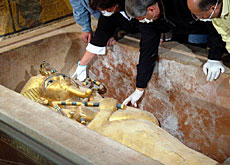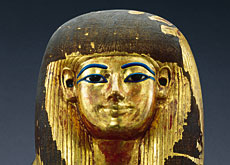Tutankhamun murder mystery solved

A Swiss expert who examined a detailed scan of King Tutankhamun’s mummy says the young Egyptian pharaoh was not killed by a blow to the head.
But Frank Rühli believes a fracture to the king’s left leg, which theoretically could have occurred shortly before his death, may have been the source of an infection.
The Swiss anatomist and paleopathologist was one of only three international experts invited last week by the Egyptian authorities to examine a Computed Tomography (CT) scan of Tutankhamun, who died around 3,300 years ago.
The three-dimensional scan was taken in January by Egyptian archaeologists at the pharaoh’s tomb in the Valley of the Kings near Luxor.
Rühli, who works at Zurich University’s Institute of Anatomy, told swissinfo that there were no signs that the 19-year-old king had been murdered by a blow to the head.
A previous X-ray, carried out in 1968, had shown there were bone fragments loose in his skull.
“The main conclusion from the images we have seen so far is that we can completely rule out the theory that he suffered a deadly blow to his head,” said Rühli.
“We saw some pieces of bone within the skull, but we are quite convinced that these pieces come from post-mortem damage.”
Rühli said there were two possibilities for explaining the damage to the skull: it may have either occurred during the embalming process, or during the 1920s when the mummy was discovered by a team led by British archaeologist Howard Carter.
Mystery goes on
But in resolving one mystery, the investigation has given rise to another.
“We think we have some evidence for a post-traumatic fracture on the left leg [of Tutankhamun] which theoretically may have occurred during his lifetime,” said Rühli.
“We didn’t see any major signs of healing that would normally occur after one or two weeks, so that gives us a time range that stops maybe a week before death.
Rühli is convinced that the injury would not have been life-threatening, but suggests that an infection might have set in.
“If this lesion occurred during his lifetime, it in itself would most likely not have been deadly,” he said.
“But imagine the situation 3,000 years ago, such a lesion like this could have led to some sort of infection or bleeding or other triggers which would then actually contribute to death.”
No sign of disease
Otherwise, Tutankhamun was deemed to have been in “very good health”, with the mummy manifesting no signs of diseases or genetic defects.
Rühli, who spent a week in Egypt as part of the foreign investigation team, said it had been a memorable experience for a number of reasons.
“What really stands out is that we were able to do the first CT scans of a proven royal Egyptian mummy,” he said.
“This helps scientifically, because up until now we were always dealing with the mummification techniques and the diseases of the nobles and the upper classes but we never really focused on the highest level – the pharaohs,” he said.
“It was just a dream and a chance of a lifetime to be part of this, and I’m very grateful to the Egyptians that they actually allowed foreigners to come and look at the mummy, which is probably the most famous in the world,” added Rühli.
Left in peace
The Swiss mummy expert agrees with Zahi Hawass, chairman of Egypt’s Supreme Council for Antiquities, that Tutankhamun should now be left in peace.
He says it would be difficult to glean any more information from the king’s mummy without going down a more invasive route and removing tissue samples to carry out DNA analysis.
“My personal opinion is that it would be better to leave the mummy as it is now, because we have done quite an exhaustive job with the CT scanner, and we can’t really do much more at this stage,” he said.
“We have closed another chapter but I am pretty sure that the next one will be written in a few years’ time.”
swissinfo, Adam Beaumont
Frank Rühli works a Zurich University’s Institute of Anatomy.
One of his specialisms is paleopathology, looking at diseases of the past.
Rühli, along with two Italian experts, spent last week in Cairo looking at the CT scan.
The detailed X-ray of the mummy was taken by the Egyptians in January.
Researchers say there is no evidence to show that Tutankhamun was killed by a blow to the head.
Damage to the pharaoh’s skull may have occurred during the embalming process or during an archaeological expedition in the 1920s.
But the investigation revealed a fracture to the young king’s left leg which may theoretically have been the source of a deadly infection.

In compliance with the JTI standards
More: SWI swissinfo.ch certified by the Journalism Trust Initiative

You can find an overview of ongoing debates with our journalists here. Please join us!
If you want to start a conversation about a topic raised in this article or want to report factual errors, email us at english@swissinfo.ch.